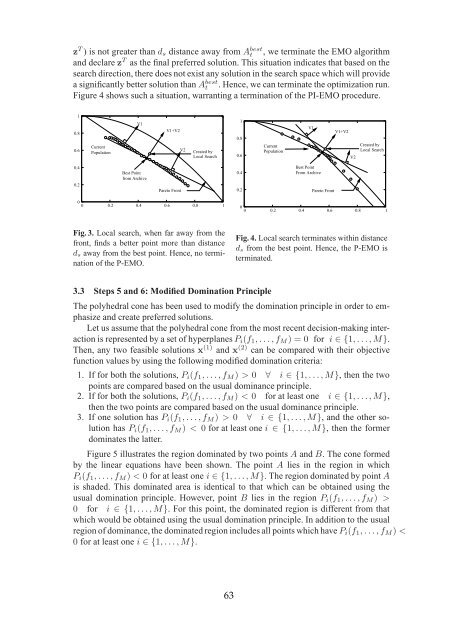Progressively Interactive Evolutionary Multi-Objective Optimization ...
Progressively Interactive Evolutionary Multi-Objective Optimization ...
Progressively Interactive Evolutionary Multi-Objective Optimization ...
Create successful ePaper yourself
Turn your PDF publications into a flip-book with our unique Google optimized e-Paper software.
zT ) is not greater than ds distance away from Abest t , we terminate the EMO algorithm<br />
and declare zT as the final preferred solution. This situation indicates that based on the<br />
search direction, there does not exist any solution in the search space which will provide<br />
a significantly better solution than Abest t . Hence, we can terminate the optimization run.<br />
Figure 4 shows such a situation, warranting a termination of the PI-EMO procedure.<br />
1<br />
0.8<br />
0.6<br />
0.4<br />
0.2<br />
Current<br />
Population<br />
V1<br />
Best Point<br />
from Archive<br />
V1+V2<br />
Pareto Front<br />
V2<br />
Created by<br />
Local Search<br />
0<br />
0 0.2 0.4 0.6 0.8 1<br />
Fig. 3. Local search, when far away from the<br />
front, finds a better point more than distance<br />
ds away from the best point. Hence, no termination<br />
of the P-EMO.<br />
3.3 Steps 5 and 6: Modified Domination Principle<br />
1<br />
0.8<br />
0.6<br />
0.4<br />
0.2<br />
Current<br />
Population<br />
V1<br />
Best Point<br />
From Archive<br />
Pareto Front<br />
V1+V2<br />
V2<br />
Created by<br />
Local Search<br />
0<br />
0 0.2 0.4 0.6 0.8 1<br />
Fig. 4. Local search terminates within distance<br />
ds from the best point. Hence, the P-EMO is<br />
terminated.<br />
The polyhedral cone has been used to modify the domination principle in order to emphasize<br />
and create preferred solutions.<br />
Let us assume that the polyhedral cone from the most recent decision-making interaction<br />
is represented by a set of hyperplanes Pi(f1, . . . , fM ) = 0 for i ∈ {1, . . . , M}.<br />
Then, any two feasible solutions x (1) and x (2) can be compared with their objective<br />
function values by using the following modified domination criteria:<br />
1. If for both the solutions, Pi(f1, . . . , fM ) > 0 ∀ i ∈ {1, . . . , M}, then the two<br />
points are compared based on the usual dominance principle.<br />
2. If for both the solutions, Pi(f1, . . . , fM) < 0 for at least one i ∈ {1, . . . , M},<br />
then the two points are compared based on the usual dominance principle.<br />
3. If one solution has Pi(f1, . . . , fM) > 0 ∀ i ∈ {1, . . . , M}, and the other solution<br />
has Pi(f1, . . . , fM) < 0 for at least one i ∈ {1, . . . , M}, then the former<br />
dominates the latter.<br />
Figure 5 illustrates the region dominated by two points A and B. The cone formed<br />
by the linear equations have been shown. The point A lies in the region in which<br />
Pi(f1, . . . , fM) < 0 for at least one i ∈ {1, . . . , M}. The region dominated by point A<br />
is shaded. This dominated area is identical to that which can be obtained using the<br />
usual domination principle. However, point B lies in the region Pi(f1, . . . , fM) ><br />
0 for i ∈ {1, . . . , M}. For this point, the dominated region is different from that<br />
which would be obtained using the usual domination principle. In addition to the usual<br />
region of dominance, the dominated region includes all points which have Pi(f1, . . . , fM) <<br />
0 for at least one i ∈ {1, . . . , M}.<br />
63
















